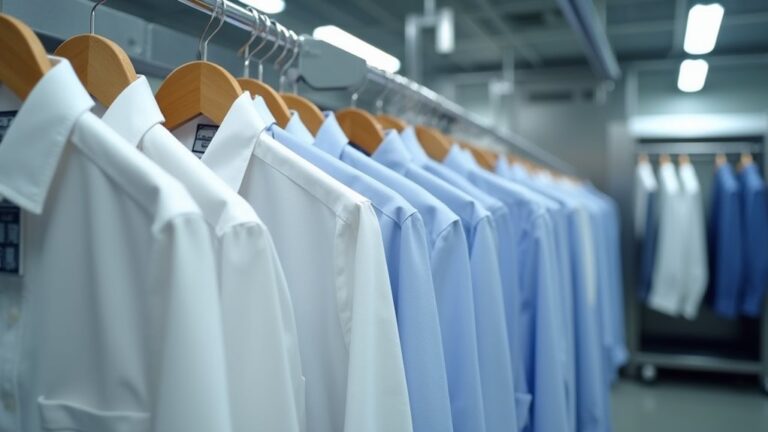You’ll find dry cleaning businesses can be quite profitable, with annual earnings typically ranging from $30,000 to $125,000, though I’ve seen prime locations pull in over $500,000 yearly. Your success really depends on nailing that sweet spot of location and managing those hefty startup costs between $200,000-$500,000. The magic number you’re aiming for is 2,000 pieces monthly to break even, which honestly isn’t as intimidating as it sounds once you build your customer base. There’s much more strategy involved than meets the eye.
Market Size and Growth Potential of the Dry Cleaning Industry
While many entrepreneurs chase flashy tech startups or trendy boutiques, the dry cleaning industry represents a surprisingly robust foundation for building wealth, with the global market hitting $69.3 billion in 2022 and steady growth projections that should make any business-minded person take notice.
You’re looking at a market size that’s expanding at roughly 7% annually through 2030, which honestly beats most traditional investments I’ve seen. The growth potential becomes even more compelling when you consider that urban areas are driving this momentum, where busy professionals consistently generate demand for dry cleaning services.
What really excites me about this industry’s profitability potential is how consumer spending on laundry services directly correlates with economic stability, creating a reliable revenue stream that weathers market fluctuations better than trendier businesses. The industry has shown remarkable resilience by adapting to market shifts, particularly through the growing demand for luxury garment care and eco-friendly cleaning solutions that command premium pricing.
Revenue Generation Models and Pricing Strategies
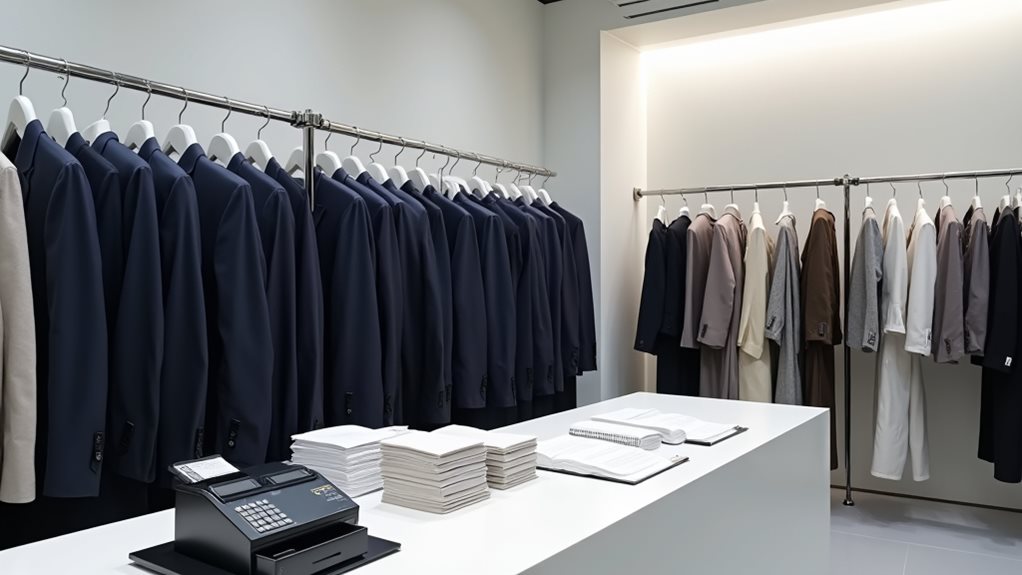
You’ll discover that building a profitable dry cleaning business hinges on mastering three interconnected revenue pillars, much like the three-legged stool my grandfather used in his workshop that wouldn’t stand without each sturdy support.
Your service pricing structure becomes the foundation, where understanding that customers willingly pay $3 for a crisp shirt but expect exceptional quality for that $30 comforter cleaning creates the delicate balance between accessibility and profitability.
Smart entrepreneurs like yourself can then amplify earnings through revenue stream diversification and subscription models, transforming occasional visitors into loyal customers who appreciate both convenience and savings 💡.
Successful operators recognize that geographic location significantly impacts pricing power, as dry cleaners in metropolitan areas can command premium rates compared to rural competitors facing lower overhead costs.
Service Pricing Structure
Three critical pricing decisions will make or break your dry cleaning business’s profitability, and I learned this the hard way during my first year when I underpriced everything and nearly went bankrupt 😅.
Your service pricing structure needs to reflect the true value of your dry cleaning services, with basic garment care ranging from $3-7 per item and complex pieces commanding $15-30.
Smart revenue generation comes from additional services like stain removal and pressing, which boost customer spending by $2-5 per visit.
I’ve found that effective pricing strategies focusing on customer retention through subscription packages create predictable cash flow, with loyal clients contributing $1000-1200 annually to your profitability while guaranteeing sustainable growth.
Understanding your target market’s spending patterns is crucial, as most households allocate $20-80 monthly for professional cleaning services, with regular customers maintaining weekly work attire cleaning routines that generate consistent revenue streams.
Revenue Stream Diversification
Although most dry cleaning owners think revenue comes from just cleaning clothes, I discovered that diversifying your income streams can transform a struggling business into a thriving enterprise that generates multiple profit centers throughout the day.
You’ll boost your average transaction value by offering additional services like alterations, shoe repair, and leather cleaning—services that command higher profit margins than basic pressing.
Smart entrepreneurs create subscription-based packages for busy professionals, building customer loyalty while guaranteeing predictable monthly income.
Specializing in delicate fabrics and special garment care attracts affluent customers who’ll pay premium prices for high-quality service.
I’ve seen owners double their revenue by adding pickup and delivery services, wedding dress preservation, and even luggage repair.
These diverse revenue streams cushion your business during slow seasons while maximizing every customer interaction.
The most successful dry cleaning operations implement these diversification strategies to achieve profit margins ranging from 15% to 25% on annual revenues between $200,000 to $300,000.
Subscription Package Models
Subscription packages have become game-changers for customer retention and revenue generation. You can offer discounted rates of 10-20% off regular pricing, which encourages long-term commitments while keeping customers coming back monthly.
The beauty of this business model lies in predictable income—instead of wondering if Mrs. Johnson will return, you know she’s locked in for the year.
Bundle additional services like alterations or specialty treatments to boost customer satisfaction and average transaction values. When customers see clear pricing structures and genuine value, they’ll gladly commit to subscriptions that benefit both your bottom line and their wallets.
This approach works particularly well in areas with high population density, where customer volume supports subscription-based pricing models.
Initial Investment and Startup Costs Required
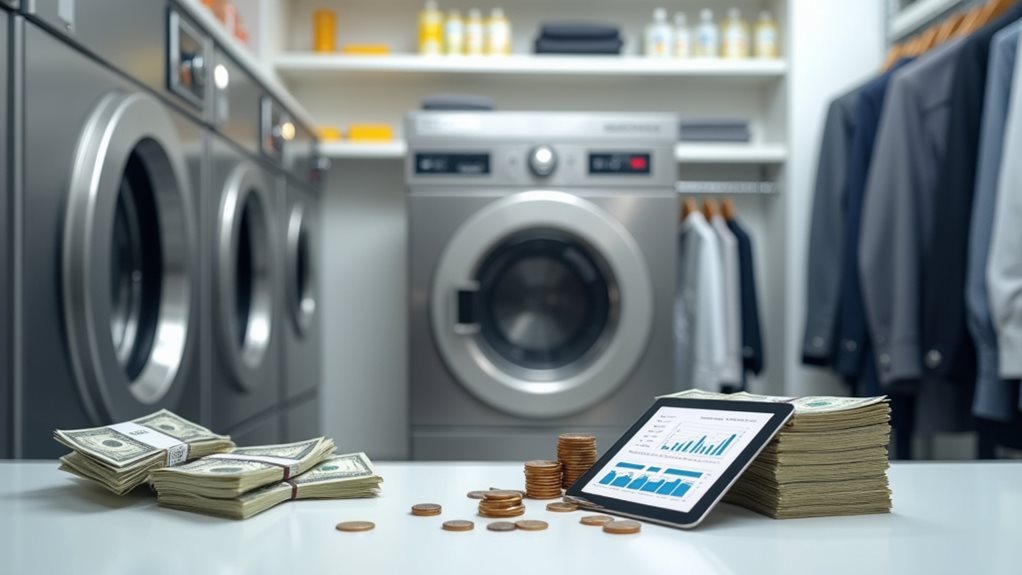
You’ll need to prepare for a hefty upfront investment when starting your dry cleaning business, and honestly, the numbers might make you gulp a little 😅 – we’re talking about $200,000 to $500,000 just to get your doors open.
The biggest chunk of your startup budget will go toward equipment and machinery costs, which can easily run $100,000 to $300,000 for those crucial commercial washers, dryers, and dry cleaning machines that’ll become the heartbeat of your operation.
Don’t forget about the smaller but equally significant licensing and registration expenses, along with insurance and permits, because these seemingly minor costs can sneak up on you and add several thousand more to your already substantial investment.
Beyond equipment and permits, you’ll also need to budget for working capital to cover your first few months of operation, which typically requires an additional $30,000 to $100,000.
Equipment and Machinery Costs
Capital requirements can feel overwhelming when you’re first exploring the dry cleaning business, and honestly, I remember the sticker shock I experienced when I started researching equipment costs for my friend’s cleaning venture a few years back.
The equipment required for professional garment care isn’t cheap – you’re looking at $100,000 to $300,000 just for crucial cleaning equipment like washers, dryers, and dry cleaning machines.
Then there’s your commercial space lease adding $2,000 to $10,000 monthly to operational costs.
Don’t forget the initial investment in cleaning chemicals ($5,000-$20,000), plus ongoing maintenance for equipment runs $1,000-$5,000 annually.
Factor in advertising costs of $5,000-$15,000, and suddenly those startup costs feel pretty substantial! 💸
Industry data shows that total startup costs typically range from $200,000 to $300,000, which aligns with the significant equipment investments required to launch a professional dry cleaning operation.
Licensing and Registration Expenses
The paperwork maze hits differently when you’re dealing with government agencies, and I’ll be honest – maneuvering licensing requirements for a dry cleaning business can feel like deciphering a foreign language, especially when you’re already stretched thin from equipment costs.
Your startup costs will include basic business license fees, which typically range from hundreds to thousands depending on local regulations, plus sales tax permits that vary wildly by state.
Environmental regulations add another layer since you’re handling hazardous materials, often requiring specialized permits that’ll bump your business plan budget.
Don’t forget insurance expenses – liability coverage is non-negotiable in this industry.
Business licensing and permits typically cost between $2,000-$5,000, which represents a relatively small portion of your total startup costs compared to equipment and facility expenses.
Smart market research upfront saves headaches later, trust me on this one!
Operating Expenses and Cost Management
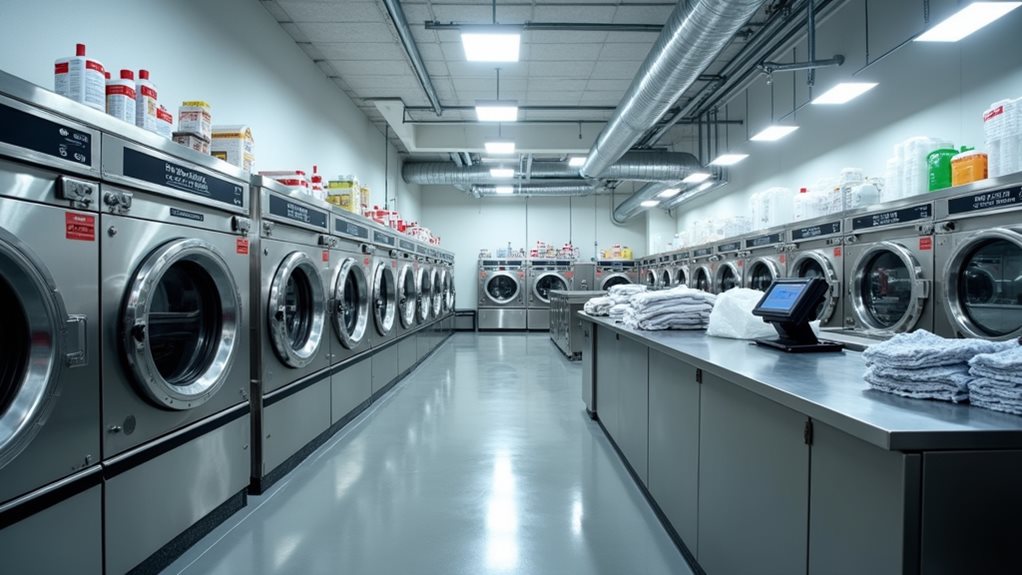
While many aspiring entrepreneurs dream of the steady income potential in dry cleaning, they often underestimate how quickly operating expenses can eat into profits if you’re not watching every dollar like a hawk.
Your major costs—rent, chemical solvents, staff wages, and utility costs—can quickly spiral if you’re not strategic about cost management.
Here’s the reality check: you’ll need roughly 2,000 pieces monthly just to break even on fixed expenses totaling around $10,000.
Those startup costs for equipment hit hard initially, but it’s the ongoing operational drain that’ll test your resolve.
With gross margins between 30-50%, successful dry cleaning businesses master the art of squeezing efficiency from every process, because profitability depends entirely on how well you control what goes out versus what comes in as revenue.
The businesses that thrive understand that net profit margins typically fall between 15% to 25%, which means controlling every expense becomes critical to achieving those annual profits of $30,000 to $125,000.
Profit Margins and Earning Potential

Looking at the numbers honestly, your earning potential in dry cleaning can range from barely scraping by to building genuine wealth, depending on how well you execute the fundamentals we’ve been discussing.
Your profit margins will typically fall between 30-50% gross, with net margins averaging 10-25% – numbers that’d make many business owners smile.
Profit margins of 30-50% gross and 10-25% net make dry cleaning an attractive business proposition for entrepreneurs.
As a dry cleaning business owner, you’re looking at monthly earnings that could be $600 if you’re struggling, $3,000 with average performance, or $15,000 when you’re firing on all cylinders.
Prime location shops with stellar customer loyalty can push past $50,000 monthly, while average cash flow revenue hits around $130,000 annually.
Your profitability depends heavily on location, efficient services, and building that coveted customer base.
Industry data shows that established dry cleaners in high-traffic areas often generate between $200,000 to $500,000 in annual revenue, demonstrating the significant growth potential available to well-positioned businesses.
Customer Base and Revenue Projections
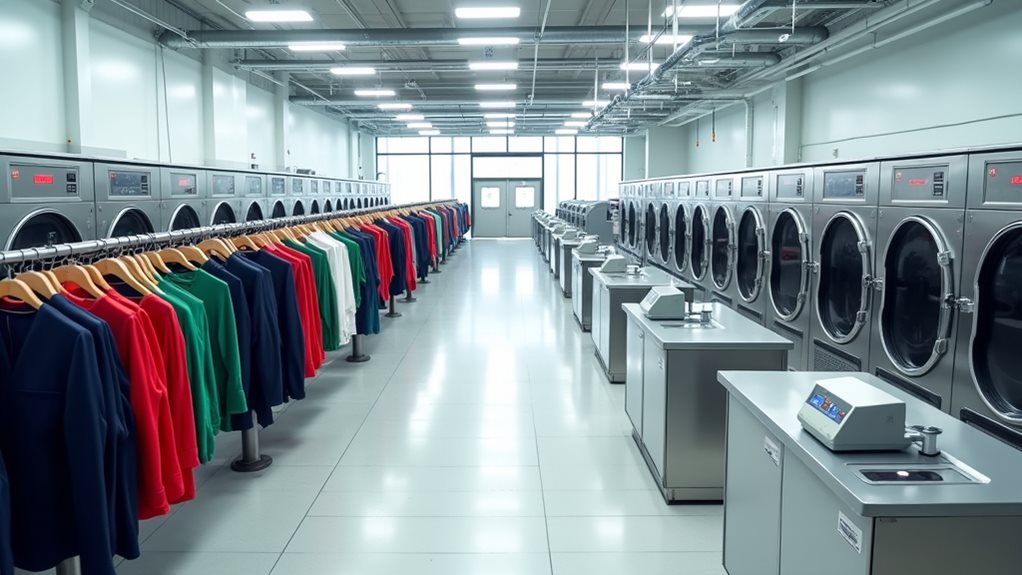
Understanding your customer base becomes the foundation for realistic revenue projections, and honestly, this part surprised me when I first dove into the dry cleaning world – customers aren’t just dropping off random shirts here and there.
Your spending patterns reveal something beautiful: loyal customers contribute $1,000-$1,200 annually, visiting 1-4 times monthly with $20-$50 per visit.
What really excites me about this dry cleaning business model is the diverse revenue streams you’ll develop – both individual customers needing weekly cleanings and businesses requiring bulk services.
Effective customer segmentation transforms these numbers into gold, because when you understand who’s walking through your door, customer retention skyrockets.
Your revenue projections will range from $2,000 monthly in small towns to $30,000 in metropolitan areas, directly impacting profitability through strategic targeting.
Factors That Impact Profitability
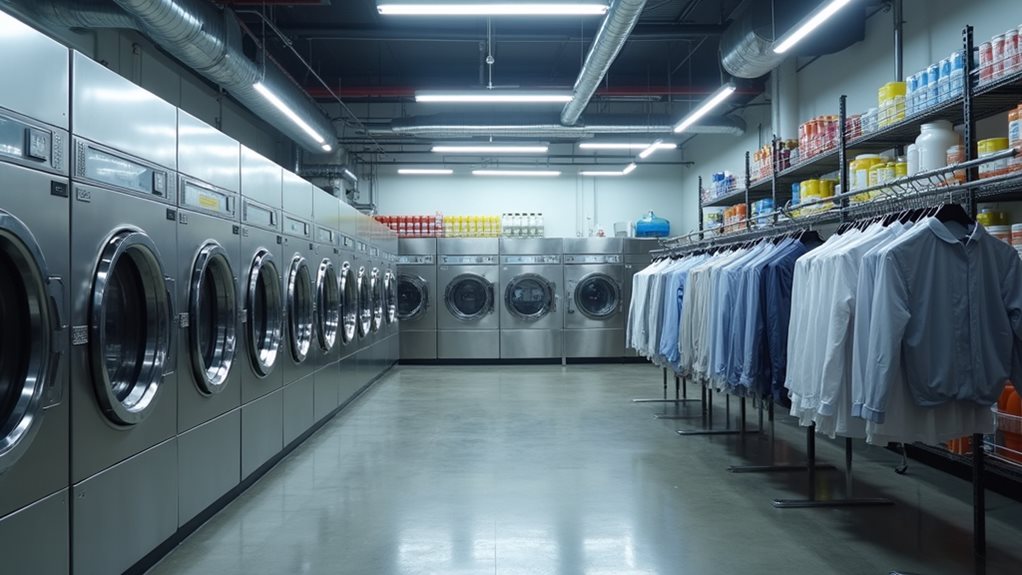
Since profitability doesn’t happen by accident in this industry, you’ll need to master the key factors that separate thriving dry cleaners from those barely keeping their doors open.
Location absolutely makes or breaks your venture—urban areas consistently outperform suburban spots because of higher foot traffic and busier professionals who value convenience over price.
Urban locations dominate the dry cleaning game—busy professionals prioritize convenience over cost, delivering the foot traffic that drives profits.
Your start-up costs will initially sting, but smart equipment choices and lease negotiations can dramatically improve your gross margins down the road.
Don’t underestimate how additional services like alterations and pickup delivery can boost revenue streams.
Competition forces you to develop clever pricing strategies while maintaining exceptional customer service, because honestly, one grumpy interaction can lose a customer forever in this relationship-driven business.
Strategies to Maximize Business Success
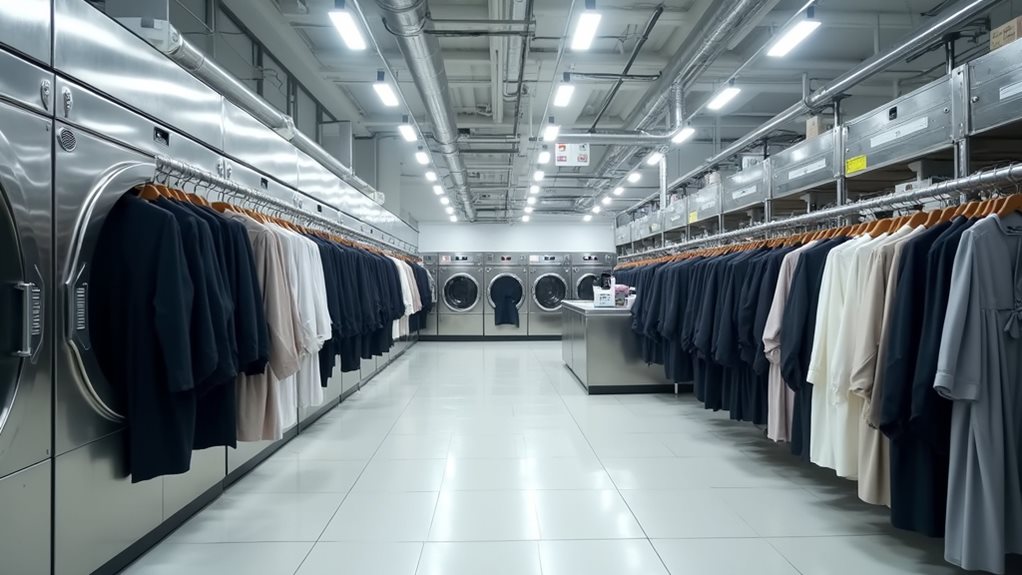
Smart dry cleaning owners don’t just survive on the basics—they thrive by implementing targeted strategies that transform their operation from a simple cleaning service into an indispensable community hub.
Your dry cleaning company’s profitability hinges on smart moves that boost both customer retention and your growth rate.
Here’s what successful owners focus on:
- Expand your service menu with additional services like alterations, stain removal, and pickup delivery to increase revenue per customer.
- Build lasting relationships through loyalty programs and regular customer discounts that keep people coming back month after month.
- Stay ahead of trends by conducting market research and offering eco-friendly cleaning options for environmentally conscious clients.
Managing operational costs while diversifying your offerings isn’t just good business—it’s your ticket to long-term success! 📈




